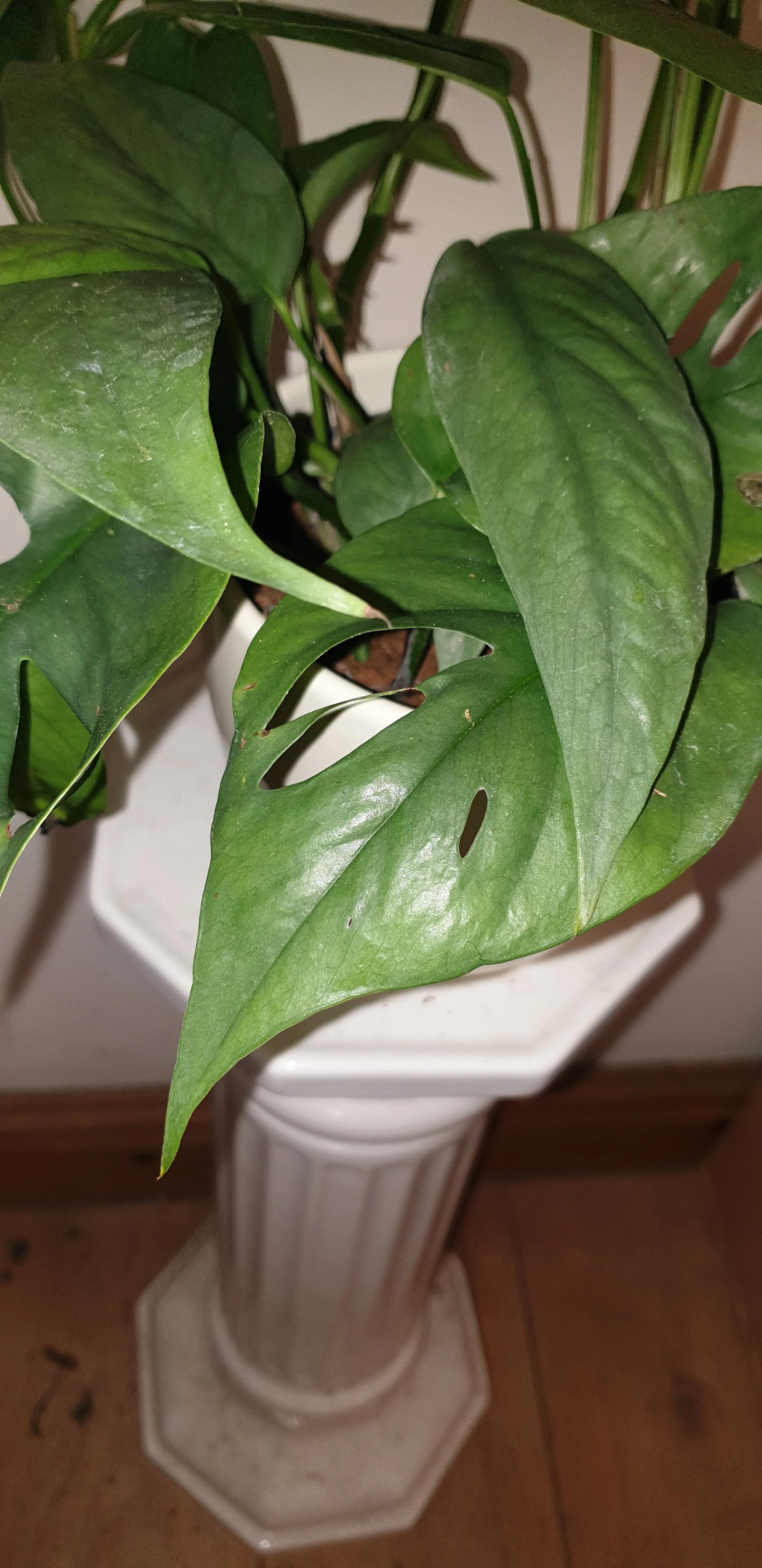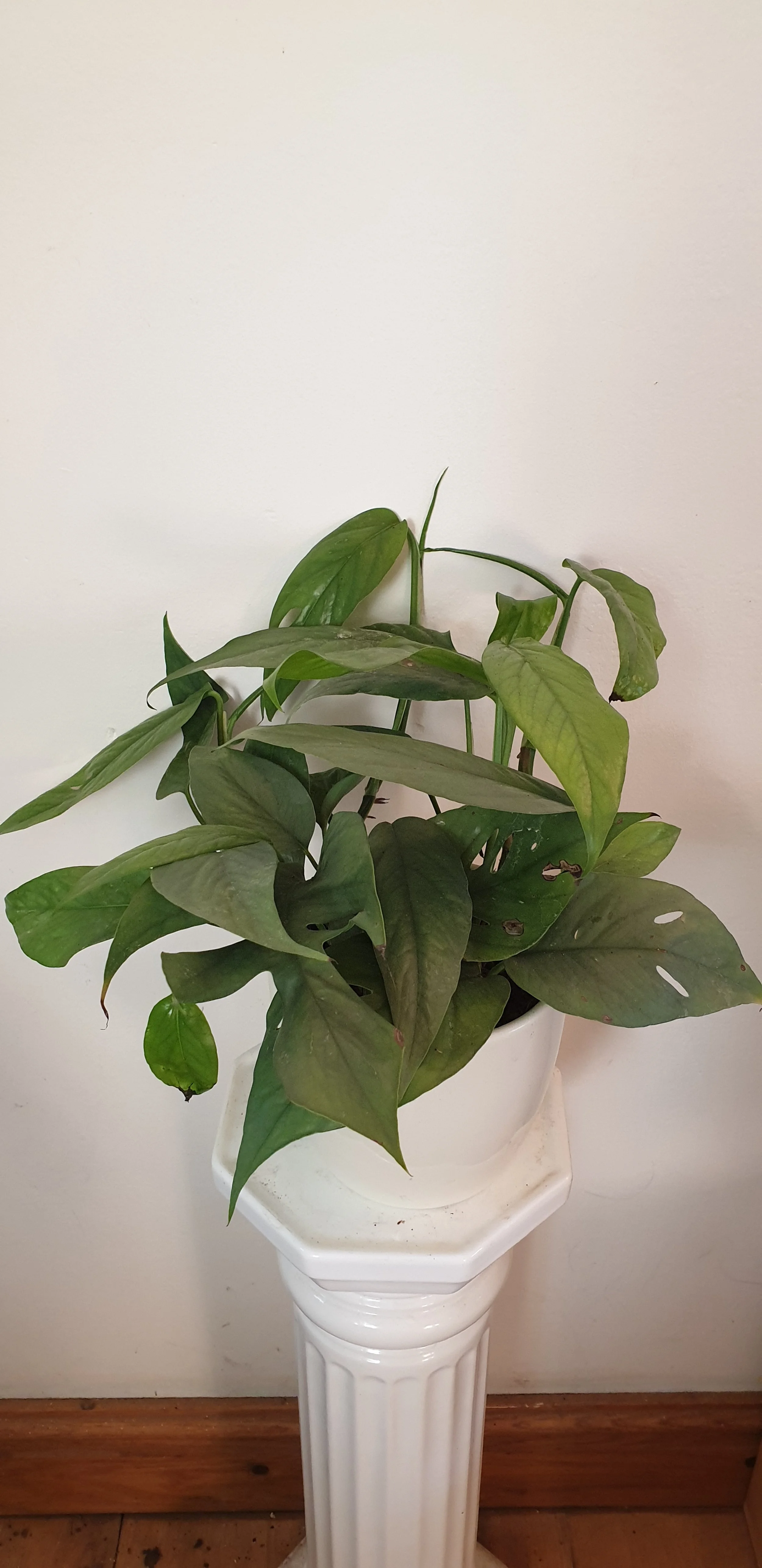 Image 1 of 2
Image 1 of 2

 Image 2 of 2
Image 2 of 2



Epipremnum 'Cebu Blue'
Epipremnum 'Cebu Blue' is a unique cultivar of Epipremnum pinnatum, prized for its shimmering, blue-green leaves and elegant trailing or climbing habit. Named after Cebu Island in the Philippines, this tropical aroid is a favorite among plant lovers for its beauty and relatively easy care.
✅ Key Features:
Foliage: Lance-shaped, narrow leaves with a metallic blue-green or silvery sheen that becomes more prominent in bright light.
Juvenile Form: Smooth, solid leaves.
Mature Form: When given support to climb, leaves can become deeply fenestrated (split), similar to Monstera or mature E. pinnatum.
Growth Habit: Fast-growing, vining or climbing plant; can trail down shelves or climb a moss pole.
Native Range: Southeast Asia, particularly the Philippines.
---
🪴 Cebu Blue Care Guide
Like other pothos relatives, Cebu Blue is relatively low-maintenance and adaptable, but thrives best with some attention to light and humidity.
---
☀️ Light
Prefers bright, indirect light.
Tolerates medium light, but variegation and leaf sheen may fade.
In strong light (but not direct sun), the plant grows faster and produces larger leaves with fenestrations.
Avoid direct sunlight, which can cause leaf burn.
---
💧 Watering
Water when the top 1–2 inches of soil are dry.
Keep soil evenly moist, but not soggy.
Cut back on watering in cooler months.
Pro Tip: It’s better to underwater slightly than overwater — Cebu Blue is semi-drought tolerant.
---
🌡️ Temperature & Humidity
Ideal temp: 65–85°F (18–29°C)
Avoid temperatures below 55°F (13°C).
Humidity: Prefers 40–60% or more. Average home humidity is fine, but growth improves with added moisture.
---
🌱 Soil
Needs a well-draining, chunky mix.
Suggested mix: 1 part potting soil + 1 part perlite + 1 part orchid bark.
Good aeration helps prevent root rot and supports fast growth.
---
🌸 Fertilizer
Feed every 4–6 weeks during spring and summer with a balanced liquid fertilizer (half strength).
Reduce or stop feeding in fall/winter when growth slows.
---
🪴 Repotting
Repot every 1–2 years or when rootbound.
Use a pot 1–2 inches larger with good drainage holes.
---
✂️ Pruning & Propagation
Prune to shape or control size. Cutting encourages bushier growth.
Easily propagated via stem cuttings in water or soil.
Ensure the cutting has at least one node (where roots grow).
---
📈 Encouraging Fenestrations
Give your plant a moss pole or trellis to climb.
Provide bright indirect light and patience—fenestrations appear as the plant matures.
---
🐛 Common Issues
Problem Cause Fix
Yellow leaves Overwatering or poor drainage Let soil dry more; check drainage
Leaf drop Low temps or shock Move to warmer, stable environment
Slow growth Low light or lack of nutrients Move to brighter spot; feed monthly
Pests Mealybugs, spider mites Treat with neem oil or insecticidal soap
---
🐾 Pet Safe?
❌ No. Epipremnum species are toxic to pets and humans if ingested (due to calcium oxalates).
---
🧘 Bonus Tip:
Cebu Blue shines best when allowed to climb—its leaf transformation from simple to fenestrated is part of what makes it so rewarding. If you’re growing it as a trailing plant, regular pruning will keep it full and lush.
Epipremnum 'Cebu Blue' is a unique cultivar of Epipremnum pinnatum, prized for its shimmering, blue-green leaves and elegant trailing or climbing habit. Named after Cebu Island in the Philippines, this tropical aroid is a favorite among plant lovers for its beauty and relatively easy care.
✅ Key Features:
Foliage: Lance-shaped, narrow leaves with a metallic blue-green or silvery sheen that becomes more prominent in bright light.
Juvenile Form: Smooth, solid leaves.
Mature Form: When given support to climb, leaves can become deeply fenestrated (split), similar to Monstera or mature E. pinnatum.
Growth Habit: Fast-growing, vining or climbing plant; can trail down shelves or climb a moss pole.
Native Range: Southeast Asia, particularly the Philippines.
---
🪴 Cebu Blue Care Guide
Like other pothos relatives, Cebu Blue is relatively low-maintenance and adaptable, but thrives best with some attention to light and humidity.
---
☀️ Light
Prefers bright, indirect light.
Tolerates medium light, but variegation and leaf sheen may fade.
In strong light (but not direct sun), the plant grows faster and produces larger leaves with fenestrations.
Avoid direct sunlight, which can cause leaf burn.
---
💧 Watering
Water when the top 1–2 inches of soil are dry.
Keep soil evenly moist, but not soggy.
Cut back on watering in cooler months.
Pro Tip: It’s better to underwater slightly than overwater — Cebu Blue is semi-drought tolerant.
---
🌡️ Temperature & Humidity
Ideal temp: 65–85°F (18–29°C)
Avoid temperatures below 55°F (13°C).
Humidity: Prefers 40–60% or more. Average home humidity is fine, but growth improves with added moisture.
---
🌱 Soil
Needs a well-draining, chunky mix.
Suggested mix: 1 part potting soil + 1 part perlite + 1 part orchid bark.
Good aeration helps prevent root rot and supports fast growth.
---
🌸 Fertilizer
Feed every 4–6 weeks during spring and summer with a balanced liquid fertilizer (half strength).
Reduce or stop feeding in fall/winter when growth slows.
---
🪴 Repotting
Repot every 1–2 years or when rootbound.
Use a pot 1–2 inches larger with good drainage holes.
---
✂️ Pruning & Propagation
Prune to shape or control size. Cutting encourages bushier growth.
Easily propagated via stem cuttings in water or soil.
Ensure the cutting has at least one node (where roots grow).
---
📈 Encouraging Fenestrations
Give your plant a moss pole or trellis to climb.
Provide bright indirect light and patience—fenestrations appear as the plant matures.
---
🐛 Common Issues
Problem Cause Fix
Yellow leaves Overwatering or poor drainage Let soil dry more; check drainage
Leaf drop Low temps or shock Move to warmer, stable environment
Slow growth Low light or lack of nutrients Move to brighter spot; feed monthly
Pests Mealybugs, spider mites Treat with neem oil or insecticidal soap
---
🐾 Pet Safe?
❌ No. Epipremnum species are toxic to pets and humans if ingested (due to calcium oxalates).
---
🧘 Bonus Tip:
Cebu Blue shines best when allowed to climb—its leaf transformation from simple to fenestrated is part of what makes it so rewarding. If you’re growing it as a trailing plant, regular pruning will keep it full and lush.